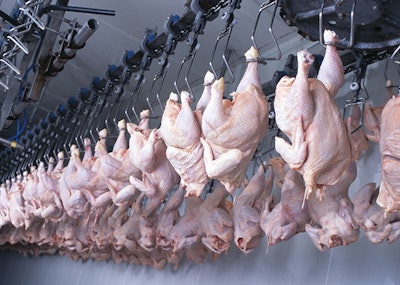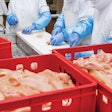
A chemical-free approach to decontamination technology can reduce bacterial contamination on poultry products.
During the process, ultrasound disrupts the airflow immediately surrounding the poultry product through intensified modular oscillations. This makes it easier for the steam to decontaminate microstructures and pits on the surface.
“For decades, scientists have tried to apply the steam treatment for food products and two things always happen. Either the steam or the intensity is adequate, so you don’t get any microbial kill or you need to use more treatment time. That always results in thermal changes of the food products, which is not desired,” Hanieh Musavian, Research Manager, Business development, Sanovo Technology Group, said.
The simultaneous steam-ultrasound decontamination lasts only one to two seconds. This means that the treatment is stopped before heat can penetrate or negatively impact the skin or meat quality of the poultry products.
A chemical-free approach to decontamination
Antimicrobial, drug and chemical resistance is a major challenge for poultry processing. A growing number of Salmonella and Campylobacter strains have become multi-drug resistant, according to a March 2020 report from the European Centre for Disease Prevention and Control (ECDC) and the European Food Safety Authority (EFSA).
“What we are seeing is that many processors begin with the recommended concentration and then the bacteria starts to get tolerance or event resistant so that they have to increase the chemical concentration and that’s an very bad unfortunate loop,” said Musavian.
“One of the benefits of this technology is that it doesn’t use any chemicals at all.”
More than 48 million Americans get sick from a foodborne illness each year and 3,000 people die as a result, the Center for Disease Control and Prevention (CDC) estimates. Contaminated poultry meat is the underlying cause of 19% of deaths attributed to foodborne illnesses.
Proven reduction in pathogens
The technology has been tested in six full-scale installations that processed whole carcasses over the past few years, with no visible or thermal changes seen. In addition, steam-ultrasound decontamination reduced pathogens such as Campylobacter and TVC by 90-95 percent on poultry carcasses, according to a study published in the journal Elsevier.
More recently, the decontamination technology reduced Salmonella and Enterobacteriaceae by 85% on turkey breast fillets. A bacterial reduction of 95 percent was seen when steam-ultrasound was applied to freshly slaughtered skin on parts.
“Cuts have a higher risk of being infected because you have more handling in the cut-up plants. There’s also the risk of cross-contamination because of all the conveyer belts used throughout the whole process,” Musavian explained.
Like what you just read? Sign up now for free to receive the Poultry Future Newsletter.
















